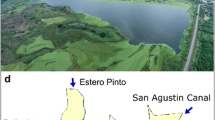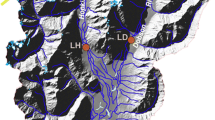Abstract
The purpose of the palaeolimnological research project carried out at Øvre Neådalsvatn was to apply a number of physical and biological proxy-climate analyses to recent sediments and to compare the results of these analyses with instrumental records of climate. Using a radiometric chronology to match the sediment core with the calendar ages of the reconstructed instrumental record, and by time-averaging the instrumental record, the statistical significance of the relationships between each of the sediment-climate proxies and the reconstructed instrumental-climate measurements were evaluated.
Acid deposition at Øvre Neådalsvatn has been low and its impact limited. Whilst there has been an overall rise in mean annual temperature of about 1 °C since 1900, the physical and biological sediment records studied appear to be insensitive to climate warming of this magnitude. On the one hand, this may be a result of the loss in temporal resolution caused by time-averaging the instrumental data; on the other hand, the lake may be insensitive to the impact of this climate change.
Similar content being viewed by others

References
Aagaard, K., 1978. The Chironomidae of the exposed zone of Øvre Heimdalsvatn. Holarct. Ecol. 1: 261-265.
Agustí-Panareda, A. & R. Thompson, 2002. Reconstructing air temperature at eleven remote alpine and arctic lakes in Europe from 1781 to 1997 AD. J. Paleolim. 28: 7-23.
Appleby, P. G., P. J. Nolan, D. W. Gifford, M. J. Godfrey, F. Oldfield, N. J. Anderson & R. W. Battarbee, 1986. 210Pb dating by low background gamma counting. Hydrobiologia 141: 21-27.
Appleby, P. G. & F. Oldfield, 1978. The calculation of 210Pb dates assuming a constant rate of supply of unsupported 210Pb to the sediment. Catena 5: 1-8.
Appleby, P. G., N. Richardson & P. J. Nolan, 1992. Self-absorption corrections for well-type germaniun detectors. Nucl. Inst. Meth. B71: 228-233.
Battarbee, R. W., 1986. Diatom analysis In Berglund B. E. (ed.), Handbook of Holocene Palaeoecology and Palaeohydrology. John Wiley, Chichester, 527-570.
Battarbee, R. W., R. Thompson, J. Catalan, J.-A. Grytnes & H. J. B. Birks, 2002a. Climate variability and ecosystem dynamics of remote alpine and arctic lakes: the MOLAR project. J. Paleolim. 28: 1-6.
Battarbee, R. W., J.-A. Grytnes, R. Thompson, P. G. Appleby, J. Catalan, A. Korhola, H. J. B. Birks, E. Heegaard & A. Lami 2002b. Comparing palaeolimnological and instrumental evidence of climate change for remote mountain lakes over the last 200 years. J. Paleolim. 28: 161-179.
Battarbee, R. W. & M. J. Kneen, 1982. The use of electronically counted microspheres in absolute diatom analysis. Limnol. Oceanogr. 27: 184-188.
Cameron, N. G., N. L. Rose, P. G. Appleby, Ø. A. Schnell, R. W. Battarbee, S. T. Patrick & R. J. Flower, 1993. AL:PE 1: Palaeolimnology. ECRC Research Report No. 4. Environmental Change Research Centre, University College London.
Cameron, N. G., H. J. B. Birks, V. J. Jones, F. Berge, J. Catalan, R. J. Flower, J. Garcia, B Kawecka, K. A. Koinig, A. Marchetto, P. Sánchez-Castillo, R. Schmidt, M. Šiško, N. Solovieva, E. Štefková & M. Toro, 1999. Surface-sediment and epilithic diatom pH calibration sets for remote European mountain lakes (AL:PE Project) and their comparison with the Surface Waters Acidification Programme (SWAP) calibration set. J. Paleolim. 22: 291-317.
Dearing, J. A., J. F. Boyle, P. G. Appleby, A. W. Mackay & R. J. Flower, 1998. Magnetic properties of recent sediments in Lake Baikal, Siberia. J. Paleolim. 20: 163-173.
Duff K. E., B. A. Zeeb & J. P. Smol, 1995. Atlas of Chrysophycean Cysts. Kluwer Academic Publishers, Dordrecht, The Netherlands, 189 pp.
Flössner, D., 1972. Kiemen-und Blattfüsser, Branchipoda: Fiscläuse Branchiura. Die Tierwelt Deutschlands. 60: 1-499.
Frey, D. G., 1960. The ecological significance of cladoceran remains in the lake sediments. Ecology 41: 684-699.
Glew, J. R., 1989. A new trigger mechanism for sediment samplers. J. Paleolim. 2: 241-243.
Goodwin, T. W. (ed.), 1976. Chemistry and Biochemistry of Plant Pigments. Academic Press.
Goulden, C. E., 1964. The history of the cladoceran fauna of Esthwaite Water (England) and its limnological significance. Arch. Hydrobiol. 60: 1-52.
Guilizzoni, P., G. Bonomi, G. Galanti & D. Ruggiu, 1983. Relationship between sedimentary pigments and primary production: evidence from core analyses of twelve Italian lakes. Hydrobiologia 103: 103-106.
Hann, B. J., 1989. Cladocera. Methods in Quaternary Ecology. Geosci. Canada. 16.
Harmsworth, R. V., 1968. The developmental history of Blelham Tarn (England) as shown by animal microfossils, with special reference to the Cladocera. Ecol. Monogr. 38: 223-241.
Hofmann, W., 1978. Bosmina (Eubosmina) populations of Grosser Plöner See and Schöhsee lakes during late-glacial and postglacial times. Pol. Arch. Hydrobiol. 25: 167-176.
Hofmann, W., 1987. Cladocera in space and time: analysis of lake sediments. Hydrobiologia 145: 315-321.
Korhola, A., 1999. Distribution patterns of Cladocera in subarctic Fennoscandian lakes and their potential in environmental reconstruction. Ecography 22: 357-373.
Korhola, A., 1992: The early Holocene hydrocere in a small acid hilltop basin studied using crustacean remains. J. Paleolim. 7: 1-22.
Korhola, A., S. Sorvari, S., M. Rautio, P. G. Appleby, J. A. Dearing, N. L. Rose, A. Lami & N. G. Cameron, 2002. A multi-proxy analysis of climate impacts on recent ontogeny of subarctic Lake Saanajärvi in Finnish Lapland. J. Paleolim. 28: 59-77.
Krause-Dellin, D. & C. Steinberg, 1986. Cladoceran remains as indicators of lake acidification. Hydrobiologia 143: 129-134.
Lami, A., F. Niessen, P. Guilizzoni, J. Masaferro & C. A. Belis, 1994. Palaeolimnological studies of the eutrophication of volcanic Lake Albano (central Italy). J. Paleolim. 10: 181-197.
Lami, A., P. Guilizzoni & A. Marchetto, 2000. High resolution analysis of fossil pigments, carbon, nitrogen and sulphur in the sediments of eight European Alpine lakes: the MOLAR project. In: Lami, A., N. Cameron & A. Korhola (eds), Paleolimnology and Ecosystem Dynamics at Remote European Alpine Lakes. J. Limnol. 59(suppl. 1): 15-28.
Nilssen, J. P. & S. Sandøy, 1990. Recent lake acidification and cladoceran dynamics: surface sediment and core analyses from lakes in Norway, Scotland and Sweden. Phil. Trans. r. Soc., Lond. B 327: 299-309.
Palecki, M. A. & R. G. Barry, 1986. Freeze-up and break-up of lakes as an index of temperature changes during the transition seasons: a case study for Finland. J. Clim. Appl. Meteor. 25: 893-902.
Rautio, M., 1998. Community structure of crustacean zooplankton in subarctic ponds effects of altitude and physical heterogeneity. Ecography 21: 327-335.
Rose, N. L., 1994. A note on further refinements to a procedure for the extraction of carbonaceous fly-ash particles from sediments. J. Paleolim. 11: 201-204.
Rose, N. L., S. Harlock & P. G. Appleby, 1999. The spatial and temporal distributions of spheroidal carbonaceous fly-ash particles (SCP) in the sediment records of European mountain lakes. Water Air Soil Pollut. 113: 1-32.
Sandøy, S. & J. P. Nilssen, 1986. A geographical survey of littoral crustacea in Norway and their use in paleolimnology. Hydrobiologia 143: 277-276.
Schmidt, R. & R. Psenner, 1992. Climatic changes and anthropogenic impacts as causes for pH fluctuations in remote high alpine lakes. Documenta Ist. Ital. Idrobiol. 32: 31-57.
Schnell, Ø. A., 1996. Chironomids as a tool in monitoring climate change. Part 1: Effects of climate changes on subfossil chironomid communities in alpine lakes. Project report to the Norges Forskningsråd.
Sæther, O. A., 1979. Chironomid communities as water quality indicators. Holarct. Ecol. 2: 65-74.
Thompson, R. & F. Oldfield, 1986. Environmental Magnetism. Allen and Unwin, London, 227 pp.
Walden, J., F. Oldfield & J. P. Smith (eds), 1999. Environmental Magnetism: a practical guide. Technical Guide, No. 6: Quat. Res. Assoc., London, 35-62.
Wathne, B. M., S. T. Patrick, D. Monteith & H. Barth (eds), 1995. AL:PE project part 1. Ecosystems Research Report, 9, Report EUR 16129 EN, European Commission, Luxembourg, 292 pp.
Wathne, B. M., S. Patrick & N. G. Cameron, 1997. AL:PE-acidification of mountain lakes: palaeolimnology and ecology. Part 2-remote mountain lakes as indicators of air pollution and climate change. NIVA report 3538-97, Oslo.
Whiteside, M. C., 1970. Danish chydorid Cladocera: modern ecology and core studies. Ecol. Monogr. 40: 79-118.
Züllig, H., 1985. Pigmente phototropher Bakterien in Seesedimenten und ihre Bedeuntung für die Seenforschung. Schweiz. Z. Hydrol. 47: 87-126.
Author information
Authors and Affiliations
Rights and permissions
About this article
Cite this article
Cameron, N., Schnell, Ø., Rautio, M. et al. High-resolution analyses of recent sediments from a Norwegian mountain lake and comparison with instrumental records of climate. Journal of Paleolimnology 28, 79–93 (2002). https://doi.org/10.1023/A:1020324019052
Issue Date:
DOI: https://doi.org/10.1023/A:1020324019052



